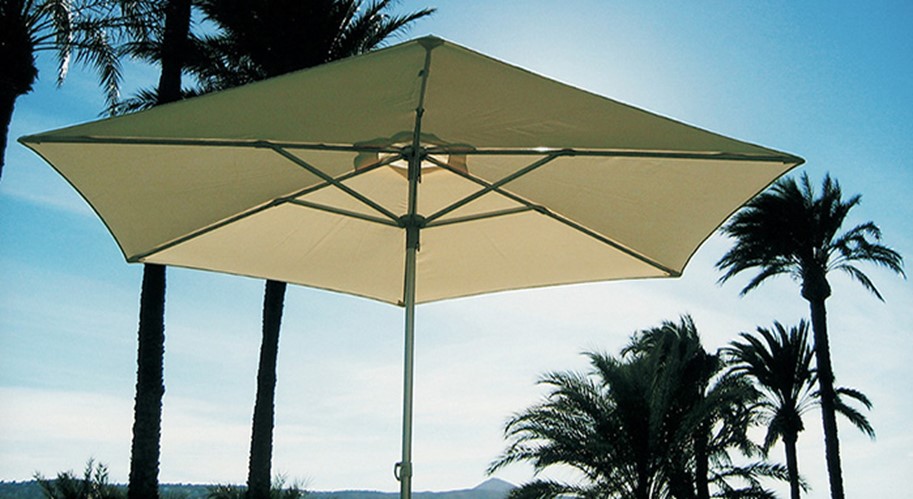
Best Patio Umbrellas for High Wind Conditions
February 17, 2022When purchasing an outdoor umbrella to complement any installation design consider the probability that bad weather conditions could eventually affect the result. It can be difficult to plan for the unpredictability of weather, but it still makes sense to understand the potential effect of high wind by examining how it can impact the umbrella system you choose.
What Factors Determine How Outdoor Umbrellas Hold Up to High Winds?
The most important element of any umbrella’s ability to withstand the wind is the type of support base used to hold the umbrella support pole in place. An outdoor umbrella with an anchoring system is the best patio umbrella for high wind conditions.
An anchored base (fastened down to the supporting surface) will almost always be more stable than a free-standing one. But reliable stability can still be attained with a base that has a large enough “footprint” (or has sufficient weight) to prevent the umbrella from becoming too top-heavy.
What Kind of Support Design Provides the Best Stability?
Single Central Pole Base
When choosing a commercial-grade umbrella, the single central pole base is usually the most wind resistant umbrella design. Reliance on a single central support makes the umbrella less likely to topple exclusively to one side if filled with air. They have a greater tendency to allow the harmless escape of air from under the rim of the umbrella canopy, enabling the umbrella to right itself as the trapped air escapes. This also minimizes potential wind damage to the canopy.
Cantilever Base
The one-arm cantilever umbrella style can be less stable than the single central pole option because its offset structural support relies on an extension arm, asymmetrically balanced, and more prone to flip.
This is much less of a problem for multi-sided cantilever umbrellas with two or more arms that can be symmetrically arranged in a more evenly-balanced configuration to resist wind shear.
Multiple cantilevers act as extra “legs” between the umbrella canopy and the base. Two, three, or four cantilever umbrellas, when deployed symmetrically, provide much sturdier support.
But adding additional umbrellas comes at a cost: multiple canopies offer more surface resistance to the wind force. Rectangular canopies also add “corners” as potential wind traps, adding to the tipping hazard. But this is easily alleviated through the use of one of the more robust base options below.
Your Choice of Base
Traditional four-sided tents and awnings often rely on corner guy wires to lock them down and prevent tipping. But a modern commercial-grade, wind resistant patio umbrella shouldn’t require such measures. Bulky tie-downs and unwieldy cables would detract from an umbrella’s beauty and functionality.


Instead, modern commercial grade patio umbrellas are built to maintain an adequate “footprint” in contact with the ground, deck, or concrete pad. They achieve this by using various base options ranging from fairly lightweight portable ground plates or hollow aluminum bases that can be filled with sand for additional weight, through heavy steel or concrete bases of increasing weight, all the way up to heavy-duty semi-permanent ground anchors that attach the umbrella support pole directly to the ground.
When choosing the best base system to anchor your commercial-grade patio umbrella, consider all available options. Particularly windy weather patterns at your installation might require more extreme anchoring methods.
Location, Location, Location
The specific outdoor placement of your umbrella will also determine how potentially exposed it may be to gusting winds. If your umbrella is near a building or sheltering wall, it might not be subjected to severe wind and shearing forces as it would be in a more exposed location. The same can be said of the local terrain; oceanfront umbrellas or those used on breezy plains or gusty mountainous terrain will probably be subjected to more wind effects than in calmer areas.
Of course, always consider the specific wind speed rating (in mph) of your commercial umbrellas. Beaufurn offers umbrella designs on a scale ranging from under 1 mph winds to upwards of 73 mph or higher (gale force winds, or 8 on the Beaufort Scale). All Beaufurn products are designed to withstand heavy weather conditions.

Sturdiest Patio Umbrella for Wind
Fortunately, Beaufurn has expended considerable effort in the development of highly wind-resistant umbrella designs that are both beautiful and functional. The three umbrellas below are superior examples of this effort:
The Réve Umbrella is a design adaptation intended to present a shallower profile, adding to its wind resistance by limiting the amount of air that can be captured beneath its canopy lip under windy conditions. It also makes use of an unusual “reverse opening/closing” procedure, in essence, opening from the top downward. This renders it less likely to turn itself inside out when struck by heavy wind, and also makes it more resistant to damage even if it does get inverted by a forceful gust.

The Voilá Umbrella is designed specifically with the effects of high wind in mind. Its unique self-stabilizing sail-wing shape provides little or no capture surface to fill with air under high wind conditions, rendering it extremely resistant to displacement or damage when subjected to heavy wind force.
The Saule P50 Umbrella is a traditional style round central pole umbrella with a shallow canopy that is designed to present a low wind profile, making it more stable than deeper umbrellas of the same type. It can be paired either with a hollow aluminum sand-filled base or a metal footplate bolted directly to the ground. It has been rated to withstand sustained winds up to 27 mph (6 on the Beaufort Scale).

In the end, there are many factors to consider when deciding which Outdoor Umbrella is best suited for your needs.
The experts at Beaufurn provide multiple options to choose from, no matter the weather conditions in your area. For more tips, read How to Choose the Right Commercial Umbrella.